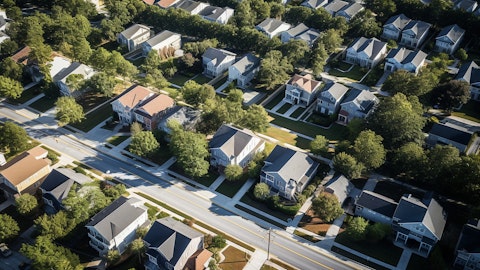Shenandoah Telecommunications Company (NASDAQ:SHEN) Q3 2025 Earnings Call Transcript October 29, 2025
Shenandoah Telecommunications Company beats earnings expectations. Reported EPS is $-0.19788, expectations were $-0.22.
Operator: Good afternoon, everyone. Welcome to the Shenandoah Telecommunications Third Quarter 2025 Earnings Conference Call. Today’s conference is being recorded. At this time, I would like to turn the call over to Mr. Lucas Binder, VP of Corporate Finance for Shentel.
Lucas Binder: Thank you, Michelle. Good afternoon, and thank you for joining us. The purpose of today’s call is to review Shentel’s results for the third quarter of 2025. Our results were announced in a press release distributed after the market closed this afternoon, and the presentation we will be reviewing is included on the Investor page on our investor.shentel.com website. Please note that an audio replay of this call will be made available later today. The details are set forth in the press release announcing this call. With us on the call today are Ed McKay, President and Chief Executive Officer; and Jim Volk, Senior Vice President and Chief Financial Officer. After the prepared remarks, we will conduct a question-and-answer session.
I refer you to Slide 2 of the presentation, which contains our safe harbor disclaimer, and I remind you that this conference call may include forward-looking statements subject to certain risks and uncertainties that may cause our actual results to differ materially from these forward-looking statements. Additionally, we have provided a detailed discussion of various risk factors in our SEC filings, which you are encouraged to review. You are cautioned not to place undue reliance on these forward-looking statements. Except as required by law, we undertake no obligation to publicly update or revise any forward-looking statements. With that, I will now turn the call over to Ed. Go ahead, Ed.
Edward McKay: Thanks, Lucas, and good afternoon, everyone. So thanks for joining us today. So as we begin the call, I’d like to share our vision for Shentel. We’re focused on 4 key pillars that are driving operational execution and positioning us for long-term value creation. First, we are focused on building on our success. We have a proud history of delivering exceptional local customer service and deploying high-quality networks in smaller markets. We’re enhancing that foundation by integrating advanced technology and AI to boost operational efficiency. For example, we’re currently using AI to streamline our technical support operations and optimize digital marketing, ensuring that the right offer reaches the right customer at the right time.
Our second pillar is successfully completing our build. Finishing our network expansion remains a top priority, and I’m very proud of our team’s achievements over the past 6 years. At the end of Q3, Glo Fiber reached a major milestone, passing 400,000 homes and businesses in our greenfield expansion markets. We remain on track to substantially complete our build by the end of 2026. Our third pillar is accelerating growth. We’re focused on driving penetration rates in Glo Fiber markets and expanding our commercial fiber business. We’re growing the size of our direct sales team, and we have simplified our online purchase experience and launched targeted digital marketing with compelling rate plans. Our 100% fiber optic Glo network gives us a clear competitive edge and our many unique commercial fiber routes connect our smaller markets back to major metropolitan data centers.
Finally, we’re focused on achieving positive free cash flow. Prior to our heavy investment cycle in Glo Fiber expansion markets, Shentel consistently delivered positive free cash flow. Returning to that position is a key milestone, and we remain on track to reach positive free cash flow for the full year 2027, driven by declining capital intensity and continued customer growth. To support this transition, we plan to refinance our credit facilities through a hybrid structure, asset-backed securitization for our Glo Fiber and commercial fiber businesses paired with a new credit facility for our incumbent broadband business. We expect this approach to lower our cost of debt, strengthen our credit profile and increase financial flexibility. These improvements will position us to capitalize on opportunities in a consolidating industry and deliver greater value to our investors.
We anticipate completing the refinancing in the coming months. Thank you for your continued trust in Shentel. We remain focused on operational excellence, strategic agility and delivering value to our customers and shareholders. Starting on Slide 4, we share some of our key highlights from the quarter. We reached the milestone of 400,000 total Glo Fiber passings, driven by 21,000 homes released to sales in the third quarter. Glo Fiber data revenue-generating units grew to 83,000 at the end of the quarter, representing year-over-year growth of 39.5% and Glo Fiber revenues grew 41.1%, reaching $21.3 million. Consolidated revenues reached $89.8 million, an increase of 2.5% year-over-year. Adjusted EBITDA climbed to $29.7 million, up 11.7% year-over-year, and our margins expanded 300 basis points to 33%.
Jim will provide you with more details on the key drivers of our financial results in a few minutes. Moving to Slide 5, we show our integrated broadband network that spans more than 18,000 fiber route miles across 8 states. Our markets have compelling competitive dynamics that differentiate us from our broadband peers. 92% of our Glo Fiber passings are duopoly markets with only one fixed broadband competitor. And in our incumbent markets, 70% of our passings have no fixed broadband competitor. On Slide 6, our sales and marketing team continues to drive growth in our Glo Fiber expansion markets. In the third quarter, we added 6,400 new customers and approximately 7,200 total data, video and voice revenue-generating units. 600 of the new customer additions were from our recent Blacksburg, Virginia acquisition that we closed and integrated in July.
Over the last 12 months, we’ve added more than 23,000 data RGUs across the Glo Fiber expansion markets. We ended the third quarter with approximately 83,000 Glo Fiber customers, 39% increase year-over-year. Our total Glo Fiber revenue-generating units reached more than 97,000 at the end of the quarter, up 37% from the same period a year ago. Moving to Slide 7, Glo Fiber passings exceeded 400,000 at the end of the third quarter, an increase of 81,000 year-over-year. Broadband data penetration in our Glo Fiber expansion markets climbed 2.1 percentage points to 20.6% at the end of the third quarter. As shown on Slide 8, growth in our Glo Fiber expansion markets has followed a consistent predictable pattern with steady increases in data penetration rates as cohorts mature.

We typically achieve 15% data penetration rates within the first year and 25% by year 3. Our earliest cohorts, which launched in 2019 and 2020 have now reached an average data penetration rate of 37%. We’re also pleased with our sales and marketing team’s ability to quickly engage customers when launching new neighborhoods as demonstrated by our 8% penetration rate for communities introduced in the third quarter. On Slide 9, monthly broadband data churn for the quarter remained steady at 1.17%. As a reminder, third quarter is the seasonally highest churn quarter due to greater move churn, especially around schools and universities. Our broadband data average revenue per user remained strong in the third quarter at roughly $77, supported by customer adoption of higher speed tiers.
In the middle of the third quarter, we introduced new promotional rate plans that offer enhanced speeds with a 5-year price guarantee. As a result of this new plan, we saw an increase in subscriber gross additions in the second half of the quarter with 68% of our new residential customers choosing speeds of 1 gig or higher, including 12% choosing speeds of 2 gig and 3% choosing speeds of 5 gig. As a greenfield overbuilder and share taker, we have not raised broadband service prices since we launched Glo Fiber 6 years ago. In addition, our fiber networks have ample excess capacity and are superior to our competitors’ DOCSIS networks in providing faster symmetrical speeds. Our new promotional plans leverage our competitive advantage as well, and we believe they will be a key driver in accelerating growth.
As more customers select these new plans, we expect minimal impact to data ARPU in the next couple of quarters and a decline of approximately 1% for 2026. Turning to Slide 10, we show our operating performance for the incumbent broadband markets. At the end of the third quarter, we served about 112,000 broadband data customers, reflecting a year-over-year increase of 580. Data voice and video RGUs totaled 160,000 at the end of the third quarter, down 3% year-over-year, primarily due to video customers moving to online streaming options. Total broadband homes and businesses passed in our incumbent markets grew to 248,000 at the end of the quarter, up about 14,000 over the same period a year ago. This increase was driven by construction of new government-subsidized passings in previously unserved areas.
As a result, approximately 20% of our incumbent broadband passings are now equipped with fiber-to-the-home technology. As shown on Slide 11, these new passings represent a strong growth catalyst in our incumbent markets, and we’re seeing data penetration exceed 45% 5 quarters after a neighborhood is launched. Our oldest cohort from first quarter of 2023 has reached 61% penetration, and we’ve achieved an aggregate penetration of 30% across more than 19,000 subsidized passings. Moving to Slide 12, monthly broadband data churn improved 6 basis points year-over-year, reaching 1.61% in the third quarter. Our rate card strategy of offering higher speeds and more value for the same price continues to be effective in mitigating churn. Broadband data ARPU declined 1% from a year ago as expected to $82.
Our commercial fiber business is highlighted on Slide 13. In the third quarter, we continued to execute with sales of almost $157,000 in incremental monthly revenue, an increase of 19% over the prior year quarter. This followed record-setting sales in the first half of the year. We’re seeing strong performance across a broad and diverse customer base, including wireless carriers, mid-market and enterprise customers, wholesale partners, educational institutions and state and local governments. Our service delivery team installed $215,000 in new monthly revenue in the third quarter, similar to prior periods. Average monthly compression and disconnect churn remained very low at 0.4% in the third quarter, driven by exceptional support from our Network Operations Center and our sales team.
So I’ll now turn the call over to Jim to walk you through our financials and outlook for the rest of 2025.
James Volk: Thank you, Ed, and good afternoon, everyone. I’ll start on Slide 15 with the financial results for the third quarter 2025. Revenue grew 2.5% to $89.8 million, driven by another quarter of strong Glo Fiber expansion market revenue growth of $6.2 million or 41.1%. The Glo Fiber revenue growth was partially offset by declines in our other lines of business. Incumbent broadband markets revenue declined $1.6 million, primarily due to a 15% decline in video RGUs due to customers switching to streaming video services. The commercial fiber revenue declined $1.1 million, primarily due to $900,000 in noncash deferred revenue adjustments for one of our national wireless carrier customers and a $500,000 decline in early termination fees earned in 2024.
Excluding these variances, commercial fiber revenue grew 2.3% over the same period in 2024. RLEC revenue declined $1.3 million, primarily due to lower government support revenue and a 21% decrease in DSL subscribers, as many of these customers have migrated to our recently constructed broadband Internet service. Adjusted EBITDA grew $3.1 million or 11.7% to $29.7 million, driven by the previously mentioned revenue growth and $900,000 in lower operating expenses as we recognize synergy savings from the Horizon acquisition. Adjusted EBITDA margins increased 300 basis points to 33% in the third quarter of 2025. Moving to Slide 16, we invested $212 million in capital expenditures year-to-date, net of $39.9 million in government subsidies collected.
We constructed over 1,700 route miles of fiber in the last year, and we have completed construction on 89% of the planned 22,000 government subsidized unserved passings in our incumbent markets. We expect to complete this construction in mid-2026, and this will be a driver of lower capital intensity in future years. Turning to Slide 17, we are reiterating our annual guidance. We expect 2025 revenues of $352 million to $357 million and adjusted EBITDA of $113 million to $118 million. CapEx, net of grant reimbursements of $55 million to $65 million, is expected to be $260 million to $290 million. I’d now like to update you on our liquidity and debt position on Slide 18. Liquidity was $230 million on September 30, including $23 million in cash, $118 million in available revolver capacity and $72 million in remaining reimbursements under available government grants.
At the end of the third quarter, we had $535 million of outstanding debt. Our first material maturity is July 2027. Thank you. And operator, we are now ready for questions.
Q&A Session
Follow Shenandoah Telecommunications Co (NASDAQ:SHEN)
Follow Shenandoah Telecommunications Co (NASDAQ:SHEN)
Receive real-time insider trading and news alerts
Operator: [Operator Instructions] Our first question will come from the line of Frank Louthan with Raymond James & Associates.
Frank Louthan: So I want to get your thoughts on creating longer-term shareholder value either through M&A, either as a buyer or a seller. Is that on the table? And then, if not, what else can you do for — to drive higher shareholder returns? And that’s the first question. And then I have a follow-up.
Edward McKay: Sure, Frank. This is Ed. Appreciate the question. The industry is consolidating, and we want to be a player in that. And we think our — the refinancing we’re working on gives us the flexibility to be a player there, and we’re looking for opportunities to expand our footprint. We’re also looking to drive efficiencies in our business. Some of the technology we’re deploying will help us there. And also, we’ll be gaining some efficiencies as we wind down our construction process.
James Volk: Yes. Frank, if I could add to that, the Glo Fiber expansion is coming to an end in 2026, and we expect the positive free cash flow inflection point is a significant accomplishment, and we will begin generating several years in front of us of significant free cash flow in ’28 and beyond. So I think that will be another driver based upon our organic plan.
Frank Louthan: Okay. All right. And then — so I think you mentioned you’re at 30% penetration in your subsized passings. Can you remind us how many subsized passings are you — have you been granted and what you get? And then ultimately, what’s sort of the target penetration for those builds?
Edward McKay: Yes. So Frank, in our incumbent cable markets, about 22,000 is what we’re targeting. And we expect penetration in the high 60% range. We also have several thousand other passings in Glo Fiber markets as well.
Operator: Our next question comes from the line of Hamed Khorsand with BWS Financial, Inc.
Hamed Khorsand: I just wanted to say your pricing action you took with Glo Fiber, what sparked that? Are you seeing increased competition or just a lack of consumer willingness to take on the new service that you have to feel like you had to do a new pricing scheme?
Edward McKay: Yes. Hamed, good question there. So Comcast launched a 5-year price guarantee in our markets in June. We did see a little bit of impact there on the gross add side, no impact on the churn side, though, but we decided to respond with our own 5-year guarantee. We’ve got enhanced bandwidth speeds. And that 5-year guarantee started in mid-August, and we’ve seen a significant lift in gross adds since then. In fact, they’re above the levels we experienced before Comcast launched their 5-year plan. But we continue to believe we have a competitive advantage there, not only with speed, but with our local customer service and our network reliability as well.
Hamed Khorsand: Why isn’t this growth leading to you raising your guidance?
James Volk: Hamed, this is Jim. I can respond to that one. It takes several quarters for growth to accumulate here. So it’s not something that you get in the first quarter. But our customer churn is very low, as you’re aware. Generally, we’ve been averaging about 1% per year. So we think these customers will be with us for 100-plus months. So it will take an accumulation of higher gross adds for a couple of quarters before we see a significant lift in our revenues and EBITDA.
Operator: And I’m showing no further questions, and I would like to hand the conference back over to Jim Volk for any further remarks.
James Volk: Yes. Thank you all for joining. We’re at a very exciting point in our evolution, and we look forward to updating you at our next quarterly call. Have a good evening.
Operator: This concludes today’s conference call. Thank you for participating. You may now disconnect.
Follow Shenandoah Telecommunications Co (NASDAQ:SHEN)
Follow Shenandoah Telecommunications Co (NASDAQ:SHEN)
Receive real-time insider trading and news alerts




